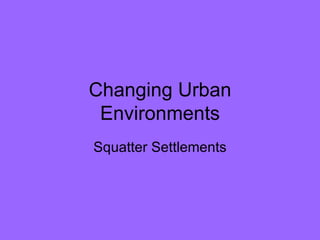Changing urban environments
- 1. Changing Urban Environments Squatter Settlements
- 2. Retro Video! Brazil ŌĆō Skyscrapers and slums While watching the video ŌĆō write down words that describe the slum area. This will be used to make a Word cloud.
- 3. ╠²
- 4. Shanty Towns in LEDC's Shanty Towns are the illegal squatter settlements that characterise most of the large cities in the developing world. They have occurred because of the huge numbers of people migrating from the rural areas to the cities. They are home to many diseases and can easily be affected by environmental disasters such as landslides and flooding. The Jhuggies of New Delhi occupy marginal land, usually beside transport routes or in hazardous areas. Many governments have bulldozed shanty towns to try to relocate the people, but this tactic hardly ever works. In Delhi schemes were introduced where the local community was closely involved in the planning and building of new houses.
- 5. There are a number of problems that are often associated with shanty towns: They are politically embarrassing to the Government, which is why many of them are now trying to help the people improve the shanty areas. The Governments feel that they may well discourage tourists from coming to the city. The houses are built of whatever the people can find, and are often major fire hazards. Their existence will reduce the prices of property in adjacent areas. They are home to many diseases and can easily be affected by environmental disasters such as landslides and flooding. Shanty Towns are called different things depending upon where you area in the world: In Rio de Janeiro and Sao Paulo (Brazil) they are called Favela's In New Delhi (India) they are called Jhuggies. In Calcutta (India) they are called Bustee's In Lima (Peru) they are called Pueblos Jovenes
- 6. Example: New Delhi, India: The Jhuggies of New Delhi occupy marginal land, usually beside transport routes or in hazardous areas. They are built from recycled materials and the 400,000 shanty homes house over 2.4 million people. They have a very high population density and very poor facilities, such as toilets, which leads to increased occurrences of diseases such as cholera and dysentry. By all building together (illegally) the residents hope that the area will become officially recognised and therefore will qualify for government funded public services, such as sewerage and electricity. Many governments have bulldozed shanty towns to try to relocate the people, but this tactic hardly ever works. In Delhi they realised that the shanty towns should become the starting point for urban redevelopment and planning. The government introduced schemes where the local community was closely involved in the planning and building of new houses. Often the government provided the materials, whilst the local people built the buildings. The government would then provide an improved infrastructure. This has occurred in many cities throughout the developing world. The Delhi Authorities have also built completely new communities away from the old shanty towns, complete with good transport links to the CBD, where many people work, and the prospects of many jobs in the new area. One such area is called Rohini. It was built in the 1980?s to house 850,000 people and provide 300,000 jobs. Similar schemes are planned for elsewhere in the city.





